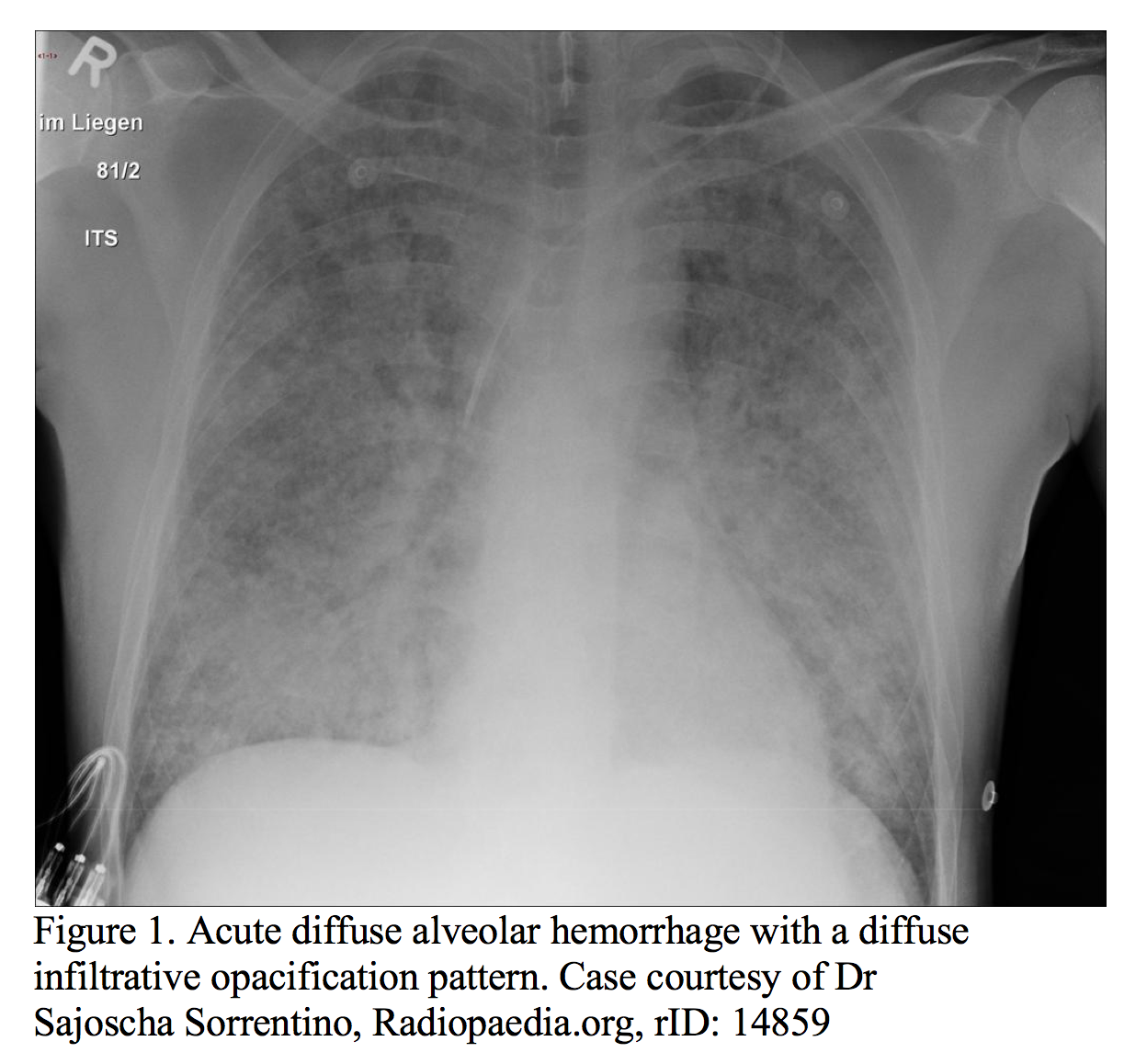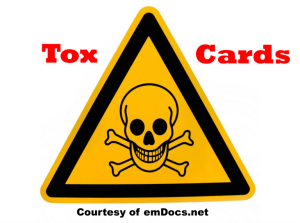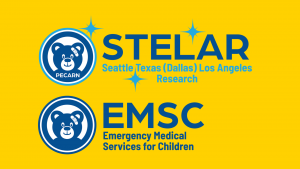Author: James L. Webb, MD (EM Resident Physician, San Antonio, TX) // Edited by: Alex Koyfman, MD (@EMHighAK) and Brit Long, MD (@long_brit)
Case
A 25-year-old Caucasian man presents with cough and hemoptysis. He was recently treated with antibiotics for community acquired pneumonia. For the past week, the patient has felt fatigued. Two days ago, cough and dyspnea started. Today, he developed hemoptysis with a small amount of dark blood. He is a non-smoker, without history or exposure to TB.
Physical exam shows a pale, alert male without respiratory distress. VS include BP 120/80, HR 85, T 37.4 C, RR 18, Sats 90% on RA. Heart sounds are normal with inspiratory crackles in both lower lung fields. The exam is otherwise unremarkable. Laboratory values are notable for serum creatinine of 5.8 mg/dL, BUN of 80 mg/dL, and hemoglobin of 10.5 g/dL. Urinalysis shows 1+ protein, RBC 45/HPF, WBC 5/HPF, and RBC casts. CXR demonstrates diffuse bilateral infiltrates.
An hour into the ED course, the patient’s respiratory status quickly deteriorates, necessitating endotracheal intubation.
After admission, laboratory tests note serum anti-GBM antibodies. What is your diagnosis?
Answer: Anti-GBM disease (Goodpasture’s syndrome)*
*Note: Terminology concerning anti-GBM and Goodpasture’s disease is difficult. UpToDate states that Goodpasture’s syndrome and anti-GBM disease is often used interchangeably, though it more often uses anti-GBM disease. Tintinalli’s, Harrison’s, and Medscape utilize anti-GBM disease and Goodpasture’s syndrome. Harrison’s states the following: Anti-GBM disease is glomerulonephritis with or without pulmonary hemorrhage. Goodpasture’s syndrome is both glomerulonephritis and pulmonary hemorrhage.
Background
Patients with circulating anti-glomerular basement membrane (anti-GBM) antibodies that target the basement membrane of the glomerulus can develop glomerulonephritis, called anti-GBM disease. Anti-GBM disease can present solely with glomerulonephritis or along with pulmonary hemorrhage. When these patients develop rapidly progressive glomerulonephritis along with diffuse pulmonary hemorrhage, this syndrome is also known as Goodpasture’s syndrome. This syndrome is uncommon, but life-threatening, and early detection is important.1-3
Anti-GBM disease is rare, occurring in less than one per million persons per year.4,5 It makes up 1-5% of all types of glomerulonephritis.3 It has shown to have a genetic susceptibility associated with certain HLA types, and is more common in Caucasian, Japanese, and Chinese populations.4,6 There is a bimodal distribution, occurring at 20-30 years and 60-70 years.3 The earlier presentation is often in men, more severe, and presents with pulmonary symptoms.1,6 Prognosis has significantly improved with therapy. Prior to therapy, the syndrome was commonly fatal. With treatment, 5-year survival rate is greater than 80%.3 Worse prognosis is correlated with higher creatinine levels and oliguria.3
Anti-GBM disease is caused by auto-antibodies specific against areas of the basement membrane type IV collagen resulting in an inflammatory process.1,2 The target antigens are expressed highly on glomerular and alveolar basement membranes, less often in renal tubules, and absent to just detectable in other tissues.7 The antibodies interface directly with the basement membrane of the glomerulus, while the alveolar basement membrane is usually protected by endothelium. However, it is thought that injury/increased vascular permeability causes exposure to the alveolar basement membrane.3,8 This can be caused by a range of factors including smoking, pneumonia, URIs, cocaine inhalation, and hydrocarbon exposure.3,8 Some consider anti-GBM disease a form of vasculitis affecting the capillary beds of certain orgains.2 The disease is often idiopathic but may occur after pulmonary infections or injury.8
Presentation
With anti-GBM disease, 20-40% have only renal involvement, and rarely do these patients have isolated lung involvement.4 Symptoms can be severe, presenting with large amounts of hemoptysis and a wide range of renal failure severity.
Renal involvement is similar to the acute renal failure seen with other types of rapidly progressive glomerulonephritis. These symptoms can include hematuria, edema, and elevated blood pressure. When severe, patient can demonstrate symptoms of uremia, such as nausea, vomiting, fatigue, confusion, lethargy, and/or coma.3,9
Pulmonary symptoms are often seen at initial presentation with hemoptysis ranging from minimal to massive leading to respiratory failure. Patients may also have cough and dyspnea. Pulmonary hemorrhage can progress rapidly, and patients may develop worsening respiratory distress, hypoxia, and tachypnea during the ED course.10,11
Patients may have systemic symptoms including fevers, chills, malaise, and arthralgias. These are also frequently seen in other vasculitides.3 Purpuric rash is more suggestive of an alternative or simultaneous different vasculitis.6 Patients may also have signs of iron deficiency anemia from persistent alveolar bleeding.10
Physical exam can show hypertension, tachypnea, respiratory distress, inspiratory rales, and edema.3
Differential diagnosis
Certain conditions can present as pulmonary-renal syndromes and should be considered in the differential diagnosis, particularly with vasculitides, lupus, or due to pulmonary edema. These conditions include granulomatosis with polyangiitis (Wegener’s granulomatosis), microscopic polyangiitis, eosinophilic granulomatosis with polyangiitis (Churg-Strauss), systemic lupus erythematosus, Henoch-Schönlein purpura, and cryoglobulinemia. Rapidly progressive glomerulonephritis can also lead to volume overload and pulmonary edema with hemoptysis.1,3
ED Evaluation
Determining the cause of pulmonary hemorrhage with glomerulonephritis is likely to be multidisciplinary. The ED course’s aim is stabilizing the patient while initiating the workup.
Laboratory assessment: CBC, BMP/CMP, UA, ESR/CRP, and coagulations studies (if massive hemoptysis).
-Urinalysis is consistent with acute glomerulonephritis: hematuria with dysmorphic red cells, proteinuria, RBC casts, and less often granular casts.4,8
-Patients will have an elevated BUN and serum creatinine secondary to renal failure.
-CBC may demonstrate anemia secondary to chronic alveolar bleeding. WBC is often elevated.3
-ESR is not usually elevated. However, ESR is frequently elevated in other vasculitides. Consider other forms of vasculitis as the source (or in addition to Goodpasture’s syndrome) if inflammatory markers are elevated.3
Obtain EKG if there is concern for hyperkalemia secondary to acute renal failure.
ED Radiology: CXR, consider CT.
-CXR may show bilateral diffuse patchy alveolar infiltrates with sparing of apices and costophrenic angles. Patients with mild pulmonary symptoms may have a normal CXR. Pulmonary effusions are uncommon.3,11

-CT may be considered in stable patients with hemoptysis, especially with unclear etiology and/or if CXR is insufficient.
Further workup: anti-GBM antibody serum assay, ANCA (to evaluate for systemic vasculitis, but many with anti-GBM disease have positive results), urgent kidney biopsy.3The definitive diagnosis of anti-GBM disease requires the presence of anti-GBM antibodies (either in serum or kidney biopsy), commonly using enzyme-linked immunoassay (ELISA) which is rapid but varies in sensitivity. Biopsy is confirmatory, prognostic, and could help guide treatment. It would show focal or segmental necrotizing or proliferative glomerulonephritis with crescent formation and immunofluorescence would show linear immunoglobulin G deposition at the glomerular capillaries.1,3,8 However, these tests are typically not available in the ED, especially upon first presentation.
ED Management
ED treatment is predominantly supportive. With severe hemoptysis, patients should be placed in an upright position if possible. Patients may need oxygenation and ventilation support. Intubation in these cases is frequently required. Acute renal failure may necessitate urgent dialysis for standard indications.1,12
Those with severe pulmonary-renal syndrome (glomerulonephritis and diffuse alveolar hemorrhage) seen in anti-GBM disease and systemic vasculitides including granulomatosis with polyangiitis, microscopic polyangiitis, and eosinophilic granulomatosis with polyangiitis are treated similarly initially. This includes airway management; often requiring intubation and dialysis. Prior to definitive diagnosis of pulmonary-renal syndromes (which require biopsies and labs), empiric treatment with methylprednisolone and plasmapheresis can be started with high clinical suspicion. Early treatment is important for preservation of renal function.1,13
If suspicion is high enough, high-dose glucocorticoids can be initiated in conjunction with rheumatology and critical care consultation: Methylprednisolone 500 – 2000mg IV in divided doses daily14,15
Otherwise, treatment is likely to be initiated after admission. Anti-GBM disease treatment comprises of plasmapheresis (to remove circulating antibodies) and immunosuppression. Patients are normally treated with glucocorticoids and cyclophosphamide.1,6,14
Those with pulmonary hemorrhage or severe renal failure requiring emergent dialysis often require ICU admission.
Key Points:
-Anti-GBM disease is caused by circulating auto-antibodies to the basement membrane resulting in glomerulonephritis and alveolar hemorrhage.
-Labwork frequently shows elevated BUN and creatinine; UA with hematuria, proteinuria, and RBC casts.
-CXR may show bilateral diffuse patchy alveolar infiltrates.
-Symptoms can progress quickly and often require intubation and dialysis.
-Empiric treatment with high-dose glucocorticoids (IV Methylprednisolone) can be started with high clinical suspicion.
References/Further Reading:
- Lewis JB, Neilson EG. Glomerular Diseases. In: Kasper D, Fauci A, Hauser S, Longo D, Jameson J, Loscalzo J. eds. Harrison’s Principles of Internal Medicine, 19e New York, NY: McGraw-Hill; 2014. http://accessmedicine.mhmedical.com/content.aspx?bookid=1130§ionid=79746753. Accessed March 18, 2018.
- Pusey CD. Anti-glomerular basement membrane disease. Kidney Int 2003; 64:1535.
- Kathuria P. Goodpasture Syndrome. 19 Nov 2017. https://emedicine.medscape.com/article/240556-overview#a1. Accessed March 18,2018
- Dammacco F, Battaglia S, Gesualdo L, Racanelli V. Goodpasture’s disease: a report of ten cases and a review of the literature. Autoimmun Rev. 2013 Sep;12(11):1101-8. doi: 10.1016/j.autrev.2013.06.014. Epub 2013 Jun 24. Review.
- Bolton WK. Goodpasture’s syndrome. Kidney Int 1996; 50:1753.
- DeVrieze BW, Hurley JA. Goodpasture Syndrome (Anti-glomerular Basement Membrane Antibody Disease) [Updated 2017 Oct 5]. In: StatPearls [Internet]. Treasure Island (FL): StatPearls Publishing; 2018 Jan-. Available from: https://www.ncbi.nlm.nih.gov/books/NBK459291
- Derry CJ, Pusey CD. Tissue-specific distribution of the Goodpasture antigen demonstrated by 2-D electrophoresis and western blotting. Nephrol Dial Transplant 1994; 9:355.
- Pusey CD, Kalluri R. Pathogenesis and diagnosis of anti-GBM antibody (Goodpasture’s) disease. 17 Jan 2018. https://www.uptodate.com/contents/pathogenesis-and-diagnosis-of-anti-gbm-antibody-goodpastures-disease. Accessed March 15, 2018.
- Sinert R, Peacock PR, Jr. Acute Kidney Injury. In: Tintinalli JE, Stapczynski J, Ma O, Yealy DM, Meckler GD, Cline DM. eds. Tintinalli’s Emergency Medicine: A Comprehensive Study Guide, 8eNew York, NY: McGraw-Hill; 2016. http://accessemergencymedicine.mhmedical.com/content.aspx?bookid=1658§ionid=109433339. Accessed March 18, 2018.
- Sims T. Hemoptysis. In: Tintinalli JE, Stapczynski J, Ma O, Yealy DM, Meckler GD, Cline DM. eds. Tintinalli’s Emergency Medicine: A Comprehensive Study Guide, 8e New York, NY: McGraw-Hill; 2016. http://accessemergencymedicine.mhmedical.com/content.aspx?bookid=1658§ionid=109439227. Accessed March 18, 2018.
- Schwartz DT. eds. Emergency Radiology: Case Studies New York, NY: McGraw-Hill; 2008. http://accessemergencymedicine.mhmedical.com/content.aspx?bookid=434§ionid=41825406. Accessed March 20, 2018.
- Smith DA. Pulmonary Emergencies. In: Stone C, Humphries RL. eds. CURRENT Diagnosis & Treatment: Emergency Medicine, 8eNew York, NY: McGraw-Hill. http://accessemergencymedicine.mhmedical.com/content.aspx?bookid=2172§ionid=165063952. Accessed March 20, 2018.
- King TE, Jr. Interstitial Lung Diseases. In: Kasper D, Fauci A, Hauser S, Longo D, Jameson J, Loscalzo J. eds. Harrison’s Principles of Internal Medicine, 19eNew York, NY: McGraw-Hill; 2014. http://accessmedicine.mhmedical.com/content.aspx?bookid=1130§ionid=79745176. Accessed March 24, 2018.
- Kaplan AA, Appel GB, Pusey CD. Treatment of anti-GBM antibody (Goodpasture’s) disease. 12 Dec 2017. https://www.uptodate.com/contents/treatment-of-anti-gbm-antibody-goodpastures-disease. Accessed March 20, 2018.
- Schwarz MI. The diffuse alveolar hemorrhage syndromes. 11 Jul 2017. https://www.uptodate.com/contents/the-diffuse-alveolar-hemorrhage-syndromes. Accessed March 24, 2018.









1 thought on “Goodpasture’s syndrome (anti-GBM disease): ED presentations, evaluation, and management”
Excelente articulo . En estos momentos se está diagnosticando una paciente de la VII década de la vida con Sx Goodpasture en n uestro hospital..